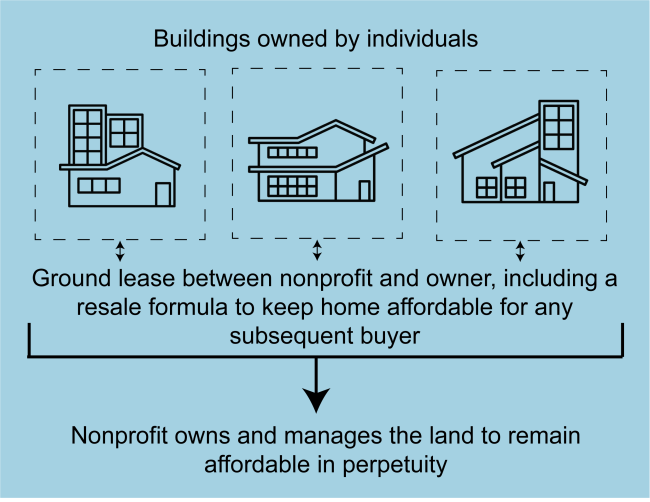To translate this page scroll up and click on the link that says "Select Language."
Para leer esta página en español desplácese hacia arriba y haga clic en el enlace que dice "Select Language" (seleccionar idioma) y elija "Spanish" (español).
What is a Community Land Trust?
A Community Land Trust (CLT) is a model of housing ownership that creates long-term affordable housing by removing the land from the speculative market. A non-profit typically owns the land and restricts affordability by placing it into a trust designed to maintain perpetual affordability, generally for 99 years.
While the non-profit owns the land, individuals own their homes and are able to build equity through homeownership. Most, if not all, CLTs are designed to promote homeownership opportunities for low and moderate-income households. When one household sells their home, the home is then preserved as affordable housing for a future low or moderate-income household. Additionally, it is typical for a land trusts’ board to be composed of community residents, allowing for direct, grassroots participation and community control.
The first CLT came out of the civil rights movement in the late 1960s through New Communities, Inc. This CLT was created to help African American farmers seek financial security and independence in a time of economic instability by “holding land in perpetual trust for the permanent use of rural communities” (The Community Land Trust Reader, 2010).
Since then, the CLT model has gained interest and momentum throughout the country, and has served as a mechanism to support affordable housing. Today, there are an estimated 277 CLTs across the United States (Democracy Collaborative).
The Draft 2023-2031 Marin County Housing Element identifies CLTs as a program to support affordable housing.
Typical CLT Homeownership Model

The graphic above illustrates the CLT model, at a high-level, which includes: 1. Buildings owned by individuals, 2. Ground lease between nonprofit and owner, including a resale formula to keep home affordable for any subsequent buyer, and 3. Nonprofit owns and manages the land to remain affordable in perpetuity.